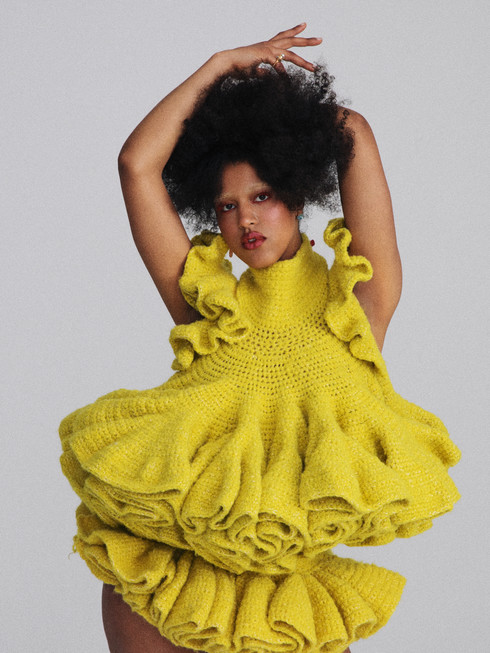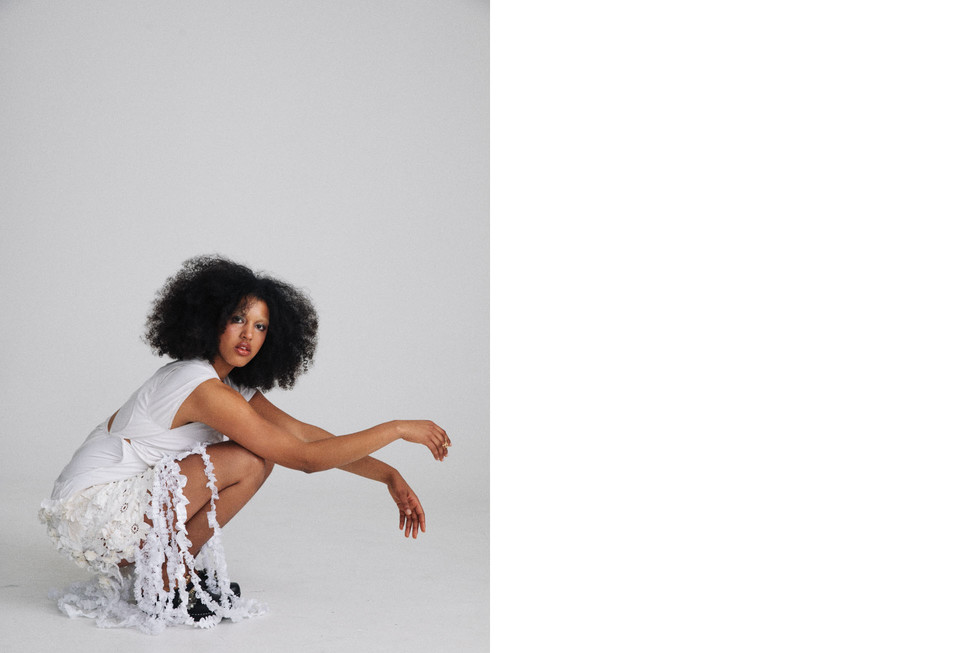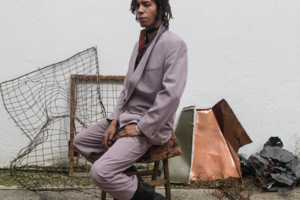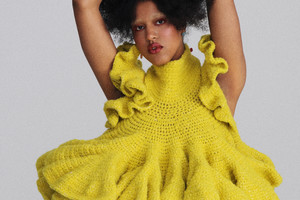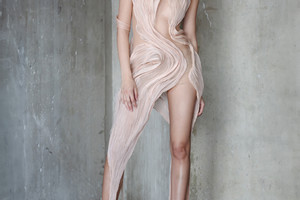Alexandre Diop about truth, Keith Haring and his creative process
Written by Natalia MunteanIn Puer Veritas creates the space for a dialogue between Keith Haring’s legendary Subway Drawings and Alexandre Diop’s assemblages on salvaged doors. Though separated by generations, both artists share a kinship: creating with found materials, in public spaces, for a world they refuse to accept as it is. On display at CFHILL Gallery, Stockholm between May 14 and August 8, 2025, the exhibition frames their shared urgency - Haring's chalked figures dancing across subway ads, Diop's nail-pierced doors bearing witness to forgotten histories.
The French-Senegalese artist discusses why “good enough” never is, his creative process and the creative dialogue with Keith Haring.
Natalia Muntean: In Puer Veritas suggests an unfiltered honesty, which is often found in children. How do you think this idea manifests in your work?
Alexandre Diop: I think it’s not just about unfiltered truth; it’s also about a genuine point of view. In French, we say that “the truth comes out of the child's mouth.” This reflects the conviction that, as a child, you still have positive, pure intentions, while the adult world is often corrupted by many things. I see this in my work. I always strive to have fun and to please myself above anyone else because I believe in my aesthetics and what’s important for me to create as an object.
NM: Were you always confident in your work?
AD: Not at all. Even today, I still have moments of struggle and doubt. I think it’s part of the practice to experience doubt. It’s like a child’s doubt, perhaps.
NM: How do you overcome those moments of doubt?
AD: By distancing myself from it and trying to understand where it’s coming from. Doubt is just that - doubt; it’s not a concrete reality. It feels similar to anxiety or fear about how others will react to your work. I remind myself that I don’t create art for others. As Sartre said, “Hell is other people.” His idea suggests that many of our problems arise from how we perceive the opinions of others. Of course, art prompts discussion, so you can’t create an artwork without considering the audience, but I always create for myself. My journey began because I was truly inspired by many artists, musicians, poets, philosophers and filmmakers. I loved their work so much that I wanted to try creating my own. When you're passionately interested in something, you naturally want to explore it yourself. Each piece helps expand my archives and process, and eventually, I will consider sharing it with others.
NM: Keith Haring worked quickly with chalk, and your art looks like you work in layers; it seems more intensive. How do you balance spontaneity with craftsmanship and deliberate actions?
AD: It often starts with a spontaneous and fast sketch. Everything comes from a sketch, a drawing, or a painting I’ll do directly on the surface. It’s about playing with the contrast of how the drawing becomes sculpture and how the combination of the initial drawing with applied material creates a visual effect. There’s a lot of rushed action because it’s physically demanding. If you start overthinking how to place each object, it takes too much time. After years of working with these techniques, it’s become practical for me. Most pieces take one to four days; some even one night, especially with pre-cut materials. There’s also destruction - sometimes I apply something and destroy it. Most of my work, even when physically demanding, is made extremely fast. If I spend too much time on the sketch, I’ll never see what it could become. Sometimes, the sketch is so strong that it carries the message itself. For faces, hands, or symbolic parts, I take more time to choose elements that match the composition and visibility.
NM: So you kind of start with a plan, but then you let your intuition guide you?
AD: Yeah, sometimes I do. For example, I have an idea, I start working on it, and then it becomes something totally different because I realise it’s not good, or I find something much more interesting in the composition. This happens often. The work becomes complex, with many layers, and it can take weeks or months. Sometimes I can’t even work on the piece - I have to hide it. But when I start working, I’m completely immersed and it affects me, in good and bad ways.
NM: Do you work on several works at the same time, or do you dedicate yourself to one?
AD: I like to work on different things, but when I start something, I want to finish it because I’m already dreaming of the idea. I think it would be nice to see this come to life soon. I also do it for myself because I want to see this beautiful object on my wall.
When I was younger, I started drawing because I lived in a white apartment in Berlin and thought it was so sad. I didn’t want to put up football posters, so I drew. Now, I work on many things at once because some pieces need to dry, or some aren’t working well. It’s easier for me to work in a series - it keeps me from being too fixated on one piece.
NM: You’ve said these doors lived lives before you. Can you share a story behind one in this exhibition?
AD: I started working with doors thanks to one of my oldest friends from Berlin. He knows how I work, how I collect materials. Back then, he helped me carry wood when I started painting on doors. Later, in Vienna, I grew bored with pre-made wood panels. I asked him to help me find old doors, raw wood, because I want to return to my initial practice. Early on in my career, I only did black work, hard, big pieces. In Vienna, entering the art world pulled me out of my darkness, my anger. When I was young, I thought I’d never paint in colour.
NM: Why were you angry?
AD: I’m still angry because there are many problems in this world, so much injustice. So many elites dominate the world, so many things aren’t right—it’s been thousands of years, centuries at least. I think it’s normal to be angry. I was angry because I can’t stand injustice - I think I got that from my parents. My mother is a social worker; my father is extremely calm and wise. They taught me not to accept everything, to follow my intuition.
When I was younger, I was angry at the perverted art market, how it assigned value based on what fit bourgeois tastes - certain colours, certain lines. I worked so hard in a dark, big studio, yet felt unrecognised. I was sure I was better than superficial artists, but it frustrated me. It didn’t stop me, though - it pushed me. If they didn’t want my work like that, I’d never try to fit in. I’d keep working in black.
My manager helped me see things differently. A good manager gives confidence, helps you discover how to transmit ideas. Amir said, “Colours don’t belong to the bourgeoisie - they belong to humanity.” I tried and realised I enjoyed colour. There were always colours in my work, but surrounded by black. I accepted it, created some of my greatest works - full of colour, but I reminded myself not to stray too far from my initial practice. Art shouldn’t just be about aesthetics - it’s about emotion. Now I’m returning to Berlin, where I started my black works, and I want to rediscover that initial roughness. I don’t want to become what I criticised.
NM: If we go back to the story about the doors…
AD: Right. I needed rough doors, but Vienna is too clean. A friend said, “The only place I know is my grandmother’s in Poland - an abandoned factory.” He went to Warsaw and brought back doors - some unused for 20 years, maybe older than me. We treated them; some even had mushrooms. Every door has a story I don’t know. All my materials come from different places - China, India, the streets.
NM: How do you get your materials?
AD: It’s a big part of my work. I started collecting out of frustration with painting. In Berlin, there’s so much abandoned stuff - dirty, wild. I’d go with a backpack and scissors - I love that adrenaline because it’s on the edge of legality, and I have had encounters with police who thought I was stealing. But it’s one of my favourite parts of the job.
NM: That’s what you enjoy most?
AD: Yes. Sometimes I struggle with my work because I don’t have the right materials. You’re working with leftovers. When I find new materials, ideas flow. If you conceptualise too much, it’s hard - but if you hunt for the right stuff, the work becomes easy.
NM: But when you go and find this material, do you already have an idea in mind of what you -
AD: I'm looking for shiny gold, but rusty. I don't need anything too plastic, too new. It should feel malleable because I need to go through it with a nail or hammer - it's delicate. I'm looking for stuff that looks antique. A lot of my inspiration comes from Africa - African sculpture, art, and my father brought from his trips to Congo, all over Africa. The material is a medium, like in African sculpture - a gateway to another world. I want material that creates an image beyond what you see. Does it create a feeling? If you look at it from the side, it shines. From another angle, it looks different. It's a lot about abstraction.
NM: Which material in this show surprised you the most? Maybe something you found by accident that changed the whole piece?
AD: Not surprised, but there's always one that's really cool. The problem is, the coolest materials are always limited. So I think, okay, this is super cool - I need to use it at the right moment. I treat this material with respect. In the show, there's this little copper piece - super beautiful, perfect for hair.
NM: What makes your work similar to Haring’s, and what makes it different?
AD: Similar? Maybe growing up in cities with creative energy around us. He grew up in 80s New York with Black gay communities, Puerto Ricans, and faced early capitalism. I grew up in Paris, then moved to Berlin in 2014. What we share first is being party kids - ravers. Both of us spent a crazy time in clubs. He was there in rave culture's most intense days. When you live in that world, it becomes like a refuge for people who don't fit into society.
NM: What did those parties give you?
AD: They were super intense. Twelve hours dancing - it gives freedom, opens your mind. The man I am was shaped by my parents, but also by Berlin. In Berlin, I was around people living completely different lives, sexually, and how they consumed everything. I arrived young and fell into the hardest scene. My crew became family, part of this Black Sheep collective. Some died. Some succeeded. It was a lot to process at 18.
NM: You said clubs are places where labels don't matter. Is your art trying to recreate that feeling?
AD: Yes, in a way. I try to show quality. Quality is universal, timeless. Someone once told me my work looks old, not modern. I said, I prefer to make old-quality work. My father said: If you do something, do it well or don't do it. Life is pressure—raising kids, relationships and art. Now I'm well-paid, so the pressure's higher.
NM: Okay, so people should feel more pressure.
AD: They should feel much more of everything.
NM: So “good enough” is not a concept you work with?
AD: Good enough? No. Of course, I'm not a fanatic dictator, and I've done many things people might think aren't cool. But good enough is not good. I'm here to speak about that, to talk, to receive criticism. You do something, people don't like it, they tell you that, you say, “Excuse me, next time I'll do better.” As an artist, what you should respect most is the public. If not, what are you doing? I make things for myself, but also for others. I want to be loved, of course.
NM: Your art is a fight to remember - what are you trying to make people remember?
AD: That I was here. That many people like me were here. That it's possible to be like me and to exist. I'm here to inspire young people, to give power back to values I believe aren't respected enough. When I say “remember me,” I mean remember these convictions I carry and defend.
NM: If Keith Haring were alive today, what conversation would you want to have with him about this show?
AD: Just to have a conversation with him would be a blessing. I wouldn't even ask anything specific. He's semi-god to me, and I'd probably be shy. Maybe I would ask how he came up with his ideas because he practically invented the smiley! He was so smart, such an entrepreneur of humanity. Gilles Vasquez, who runs his foundation now, was a 17-year-old fan back then. My level of fame is nothing compared to Haring or Basquiat - they were icons. We could never do a show together, because I'll always be far from them. And that's good. Hierarchy matters. Legends should stay legends. I'm just happy they existed.
NM: Last question - going back to kids and truth. What's one truth you've learned from children or your younger self that guides your art today?
AD: Always follow your intuition. Always. Children have this ability, even when parents or systems tell them otherwise. You can try to shape them, but children will always do what they want. They find a way.



